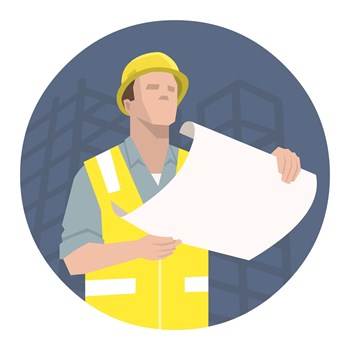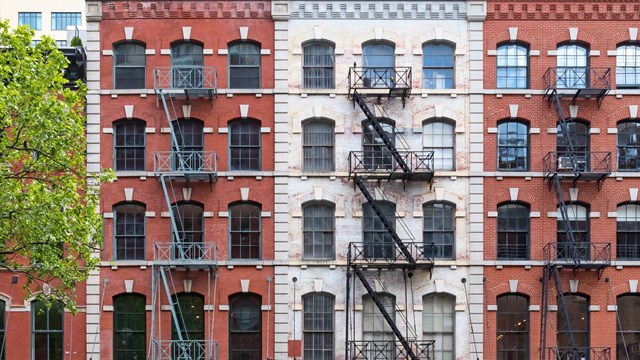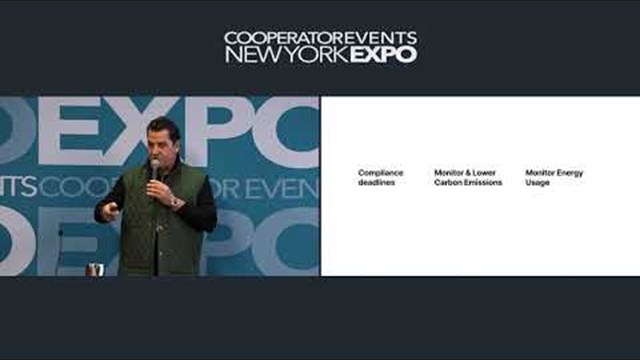
In the spring of 2019, the New York City Council passed the Climate Mobilization Act—and with it, Local Law Number 97 (LL 97). LL 97 requires large existing buildings—those over 25,000 square feet—to reduce their carbon emissions 40% by 2030 and 80% by 2050. Unique in its aim, the law targets existing buildings and requires owners to invest in renovation and retrofitting to make their buildings more energy efficient.
What’s Required, By When?
LL 97 sets requirements for all subject properties for two initial compliance periods: The first period runs from 2024 to 2029 and the second from 2030 to 2034. New York City is obligated by the law to clarify requirements for future periods through 2050. Buildings over 25,000 gross square feet must meet annual whole-building carbon intensity limits during each compliance period based on building type, or prorated for mixed-use buildings. Certain building types—including city-owned buildings, affordable housing, hospitals, and houses of worship—will have alternative compliance options if they cannot hit the carbon intensity limits.
Cooperative and condominium apartment buildings are also subject to the law. Compliance requires that building owners—which in the case of co-ops and condos means boards of directors—must submit an annual emissions intensity report approved by a registered design professional starting in 2025 or pay substantial fines. The onus is on the individual co-op corporation or condominium association not only to submit a report but to retrofit, reconfigure, and even replace polluting systems within their properties to bring their properties into compliance on a long-term basis.
What to Do
Fred Goldner is a certified energy consultant based in Long Island, and is an expert on the implementation of Local Law 97 requirements for apartment buildings and how to approach that implementation. “That implementation,” he says, “depends on the particulars of the buildings. With that said, the first step is to engage an experienced energy expert to survey the building.” That survey will determine if and where the building is currently deficient and how and where the most economical and successful changes and upgrades can be made.
Giulia Alimonti, senior architect with CTLGroup, an international engineering and architectural firm with offices in New York, advises that “boards should first become familiar with the law and options for compliance. Then they should have the building analyzed by a professional energy consultant, engineer, or architect who specializes in exterior envelope strategies to better understand their emission score. This professional will identify strategies for the reduction of consumption of fossil fuels.” It is the reduction and more efficient consumption of these fossil fuels that the law aims to achieve.
Areas for Improvement & Compliance
Stuart Halper is vice president of Impact Management. Impact has offices in New York City, Long Island, and Westchester, and manages more than 110 buildings. “The first question,” Halper says, “is where the building is at in terms of the kind of fuel they are burning. Significant savings can be achieved by burning natural gas rather than oil. A switch from oil to gas can lead to achieving compliance for Local Law 97 and also bring about major savings.”
Halper stresses that conversion to full renewable energy sources simply isn’t possible for most buildings. “We speak about renewable as solar panels,” he explains, “which won’t support a whole building, or provide heating for a multiple-family dwelling.” At a minimum, though, he suggests conversion to dual fuel configuration, using both gas and light heating oil such as Number 2 oil. “Most conversions today are dual fuel,” he says. “Eventually oil will be phased out altogether. Right now, you can burn Number 2 or 4 oil, but in a few years Number 4 will be phased out as Number 6 was previously.” Essentially, the elimination of heating oil will force conversion of heating systems to gas.
Goldner adds, “As a general rule, the change that makes the biggest difference is fuel switching. If you’re on Number 4 oil now it has a high carbon emission. Getting to a combination of Number 2 oil and natural gas is something you want to do. It will change your carbon footprint. Sometimes equipment may need to be switched or upgraded as well. You may need to change some equipment or configurations as part of the fuel conversion.”
Goldner also observes that some larger buildings may have steam absorbers or central chillers for HVAC systems. Buildings with air conditioning systems may have different types of chiller technologies, installed when oil was cheap. These buildings should consider conversion to new, more economical and environmentally friendly systems. He cautions that these properties need to look at space issues as well. Upgrading may be significantly impactful.
Fine-Tuning Your Energy Usage
Aside from reconfiguring your heating system to run on more efficient, economical, and environmentally friendly fuel, there are components of your system that monitor its efficiency that should be analyzed, calibrated, and sharpened to keep the system operating at peak performance. These components include fine tuning boiler/burner operations. “Get your heating system running efficiently,” says Goldner. “Setting controls up effectively and reducing cycling saves on both cost and emissions. You reduce cycling through boiler controls and other monitoring technologies. Reducing boiler cycling can save substantial money. This problem exists in about 70% of buildings.”
Another area for investigation is heating distribution and system balancing, Goldner continues. “Stop throwing BTUs and carbon out the window. You don’t want to see open windows in the winter—so don’t overheat the building. Proper balancing can help with this. Reduce waste. Buildings with proper system balancing can save about 20% over costs.”
Other Areas to Look At—and a Word on Solar
Alimonti suggests doing a survey of the exterior façade to look for energy loss. “Make it more solid, so nothing leaks. Façades can be overclad to prevent heat loss. Install an additional finish on the exterior wall, a metal panel with an insulation core covered with aluminum.” It does look different from the original brick, but will save energy and help with compliance.
Halper suggests looking for ‘low-hanging fruit’ to achieve savings without necessarily spending a mint. For starters, take a look at the lightbulbs in your building and grounds, and switch any incandescent bulbs to LEDs immediately. “Many buildings have lagged on this,” says Halper. “Boards often say they have too much on their plate, so they let it go—but LED bulbs are now very cheap. They burn much less energy and the bulbs last 5-10 times longer than incandescent bulbs.”
Window replacement is another area to be considered. While it is a very expensive undertaking, window systems have a useful life of about 25 years and need to be replaced on that schedule in any event. According to Alimonti, “New windows with thermo-panes will not only save money by reducing energy loss, but will also provide acoustical benefits by reducing exterior noise.” They also dramatically reduce UV radiation—to the point that she says she often uses them for apartments with expensive furniture and art to prevent fading.
While Local Law 97 encourages property owners to seek out alternative renewable energy sources, it does not require that buildings convert solely to solar sources—though many are adopting solar as part of their overall plan. The success of solar energy depends to a great extent on the orientation of the building to direct sunlight. Alimonti explains that it’s not mandatory. “Not every building has the exposure for solar,” she says. “It may not face the right way, something may be in the way—like another building, etc. So it can’t be required. But the analysis of its usefulness should be approached from a holistic view.”
Resident Buy-In
Goldner points out that a great unknown variable in the overall equation is how much residents understand and participate in reducing emissions. He stresses the importance of resident education. “Because 70-80% of electricity is used within apartments—and is outside of management control—residents must understand their own part of the building’s carbon footprint. The building will pay a carbon penalty for them if they don’t change their energy consumption habits. We need to try to effect that change inside individual apartments as well.”
In the final analysis, reducing both costs and emissions in your building will be a gargantuan effort over many years. It will involve both a financial and personal commitment from shareholders and unit owners. Local Law 97 takes the option out of participating. It’s the law, so preparing now will not only save energy and money, but a whole lot of legal hassle as well.
A J Sidransky is a staff writer/reporter with CooperatorNews, and a published novelist.









2 Comments
Leave a Comment